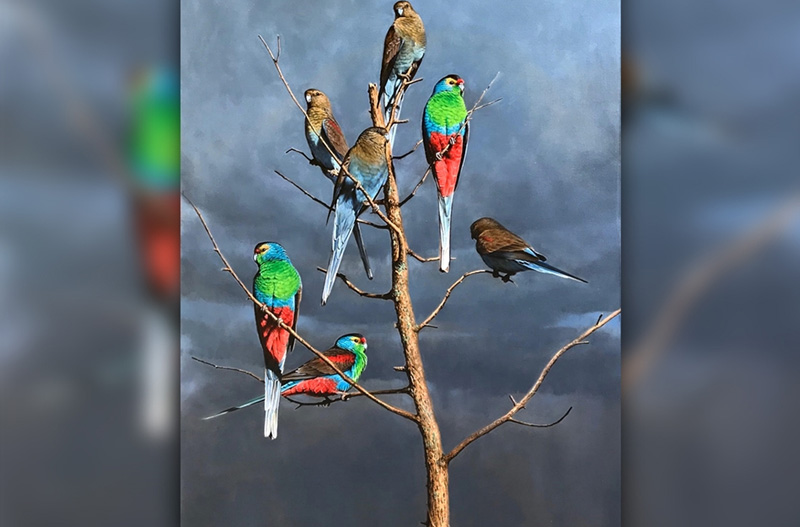
It is the year 1770. English explorer Captain James Cook has just anchored his ship the Endeavour at Botany Bay. The landmass we now recognise as Australia and its unique wildlife will never be the same again. On that very same day, almost 800 miles to the north, a party of brightly coloured parrots have alighted atop a Black Pine. Their brilliant turquoise and emerald bodies shimmer in morning sun. At certain angles their bright red shoulders seem ridiculously intense. They squabble amongst themselves for the prime perches, each bird positioning itself in the sun for maximum warmth. Warbling and chattering, their dainty bodies vibrate with an intensity that belies their small size. As the sun breaks the tree line the bush is alive with birds, the dawn chorus is almost deafening! The birds have come to drink at a small billabong…..It’s been a dry year and water is a rare resource. A pair of Brown Goshawks regularly patrol this area, so all the birds are nervous.
The pigeons are the first to approach the water…. just one or two, then literally by the hundreds, both Common Bronzewings and Bar Shouldered Doves. Finally they completely encircle the waterhole. Then other birds fly in - honeyeaters and woodswallows followed by huge flocks of grassfinches.... perhaps 500 dapperly plumaged Black throated finches with almost as many Double barred and Star finches.
Our brightly coloured parrots have been waiting their turn. First one pair, then another nervously alight some 30 feet from the water’s edge. Before long nearly 200 of them have made their way to the water. They drink with quick gulps, nervously lifting their heads back and forward and as quickly as they can. The parrots seem to come in waves, building up into huge numbers then nervously lifting off at the smallest noise. They repeat this behaviour until they’ve had their fill. Then almost as quickly as it started, it’s all over. Putting an end to the morning’s drama, a lone dingo passes by.
Our small parrots will remain unknown to science for another 70 years. By the time of their discovery by John Gilbert, they will already be in decline. The huge numbers that visited our billabong are already a thing of the past. Vast tracts of their habitat have been cleared. The native grasses on which the parrots relied are now replaced by cattle and introduced pasture.
A mere 60 years after Gilbert’s discovery (1900) and the bird we now know as the Paradise Parrot is already feared extinct. Its’ demise has been swift and unforgiving. It is not until 1920 that they are finally rediscovered. A small number of birds, perhaps as few as a dozen cling on as best they can. In 1927 the very last of her kind comes in to drink at a small billabong, the same billabong where many hundreds of her kind had once come to drink. The previously common Black throated finches and Star finches are also gone. An ecosystem once so rich and vibrant is now no more! The beautiful Paradise Parrot is now just a figment of our dreams and a reminder of what once was.